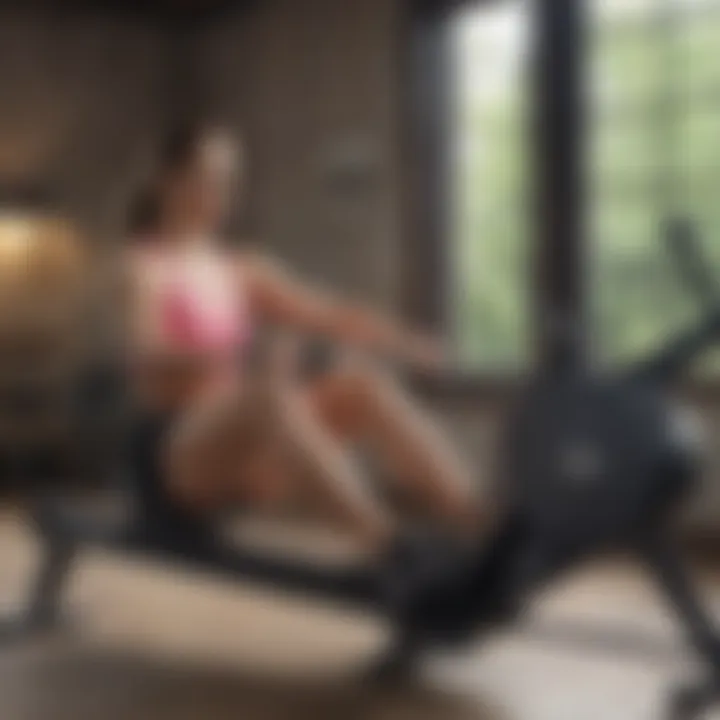Discover the Top Machines to Burn Calories Efficiently


Intro
In today’s health-conscious society, the quest for effective ways to burn calories has gained remarkable traction. Numerous individuals prioritize fitness and wellness, seeking methods that can optimally enhance calorie expenditure during workouts. The rise of various fitness machines has made it easier to tailor exercise routines that align with individual goals. This article delves into an extensive range of these machines, exploring their effectiveness, practicality, and user experiences.
Understanding calorie-burning machines is not merely about knowing which ones exist. It is crucial to comprehend how each option can cater to unique fitness needs, addressing everything from weight loss to general well-being. Furthermore, insights gathered here aim to arm readers with information needed to make informed choices about their workouts, ultimately leading to improved health outcomes.
Wellness
Wellness encompasses various elements that contribute to overall health, making this an essential aspect of fitness routines. Below are the critical factors in this context:
Physical Health
Physical health can be enhanced significantly through regular workouts. Engaging with machines specifically designed for burning calories can lead to numerous health benefits, including better cardiovascular health, increased endurance, and improved muscle strength. Each machine, from treadmills to rowing machines, offers distinct advantages in promoting calorie burn.
Mental Health
Exercise has a profound impact on mental well-being. It can help in reducing anxiety, combating depression, and enhancing overall mood. Incorporating calorie-burning machines into workouts provides a structured way to engage in physical activity. The routine itself can provide a sense of achievement, boosting the individual’s mental state.
Nutrition and Diet
While fitness machines are instrumental in calorie burning, the importance of a balanced diet cannot be overstated. Nutrition and exercise go hand-in-hand for the best results. Pairing a regimen that uses calorie-burning machines with sensible dietary choices amplifies the effects intended by workouts.
Fitness and Exercise
Diverse machines cater to different fitness levels and preferences. Some may favor high-intensity interval training (HIIT) on a stationary bike, while others might prefer a gentle session on an elliptical. Understanding what each machine offers allows individuals to choose ones that align with their fitness aspirations.
"Choosing the right machine is pivotal. It should suit both your fitness goals and your personal comfort level."
In summary, the synergy between wellness components and calorie-burning machines is essential for anyone intent on optimizing their fitness routines. Choosing the right machines can enhance both physical health and mental well-being, ultimately contributing to the overall lifestyle improvements individuals seek.
Preface to Caloric Burn
Understanding calorie burn is vital for anyone pursuing fitness and weight management. This section sets the stage for discussing various machines that can assist in maximizing caloric expenditure during workouts. By recognizing how we burn calories, we can make more informed choices about our exercise routines and the equipment we choose.
Understanding Caloric Expenditure
Caloric expenditure refers to the number of calories the body uses to perform metabolic processes and physical activities. It is divided into three main components: resting metabolic rate, thermic effect of food, and physical activity. Among these, physical activity is the primary focus for fitness enthusiasts. When engaging in physical activities, calories are burned based on the intensity and duration of the activities performed.
Key factors that influence caloric expenditure include:
- Body Composition: Muscle tissue burns more calories than fat tissue, even at rest.
- Intensity of Exercise: Higher intensity workouts result in more calories burned per minute.
- Duration of Activity: The longer the activity, the more calories expended.
To effectively burn calories, it's important to choose workouts that align with these factors. Also, combining different types of exercises can enhance overall calorie burn, helping to achieve fitness goals more efficiently.
Importance of Cardio in Weight Management
Cardiovascular exercise plays a crucial role in weight management and overall health. It elevates heart rate and increases the body's demand for energy. Here, cardio serves as a strategy for creating a caloric deficit, which is essential for weight loss.
Engaging in regular cardio not only supports weight loss but also offers various health advantages, such as:
- Improved Heart Health: Strengthens the heart and lungs, enhancing endurance.
- Increased Metabolism: Regular cardio can elevate resting metabolic rate, aiding long-term weight management.
- Enhanced Mood: Cardio has been shown to have positive effects on mental well-being, reducing stress and anxiety.
For the best results in weight management, integrating cardio exercises with strength training is advisable. Both types of workouts contribute to caloric burn, muscle maintenance, and metabolic health. In summary, understanding caloric burn and the role of cardio provides a solid foundation for making informed decisions about fitness pursuits.
Cardiovascular Machines Overview
Cardiovascular machines play a critical role in fitness regimes. They cater to various fitness levels and goals, providing a means to enhance endurance, promote heart health, and facilitate weight loss. Understanding these machines is essential, especially when it comes to maximizing caloric burn. Moreover, they offer various options that can suit individual preferences, making workouts more enjoyable and sustainable.
The benefits of cardiovascular equipment are manifold. First, they usually allow users to track their progress effectively. Many machines come with built-in monitors that provide feedback on heart rate, calories burned, and session duration. This data is invaluable in tailoring workouts to meet specific goals.
Second, these machines typically offer lower-impact alternatives for those concerned about joint health. For example, stationary bikes and ellipticals are known for their gentle motion, minimizing the risk of injury while still promoting cardiovascular fitness.
Defining Cardiovascular Equipment
Cardiovascular equipment refers to any machine designed to improve cardiovascular fitness through aerobic exercise. Common examples include treadmills, stationary bikes, rowing machines, and ellipticals. Each of these devices offers unique features and mechanics, allowing users to engage different muscle groups while maintaining an elevated heart rate.
Treadmills allow for both walking and running, providing a versatile option for those who prefer on-ground exercises. Stationary bikes, including recumbent and upright variations, are excellent for those focusing on lower-body strength while still benefiting from a heart-pumping workout.
Rowing machines simulate actual rowing, engaging the legs, arms, and core, making it a full-body workout. Lastly, elliptical machines offer a combination of upper and lower body movement, usually with a focus on having a fluid, low-impact exercise.
Comparison of Various Machines
When considering the best choice for caloric burn, it’s essential to compare the following cardiovascular machines:
- Treadmills: These are often seen as the gold standard for burning calories. Users can vary speed and incline to increase intensity. However, they may not be suitable for everyone due to the impact on joints.
- Stationary Bikes: Good options for low-impact cardio that still allows for significant calorie burns. They come in upright and recumbent forms, with the latter being more supportive for those needing back support.
- Rowing Machines: These provide one of the most engaging full-body workouts, allowing users to burn calories effectively while also strengthening multiple muscle groups.
- Ellipticals: They allow for a natural, smooth motion that decreases the risk of impact injuries, making them a popular choice among gym-goers.
Ultimately, each machine has its own set of strengths and weaknesses. Understanding these differences will enable individuals to select the most suitable equipment for their specific fitness goals and preferences.
Treadmills and Their Efficiency


Treadmills play a crucial role in cardiovascular fitness. They allow users to engage in a highly controlled walking or running environment. This adaptability makes treadmills suitable for various fitness levels—from beginners to advanced athletes. Their prominence in gyms speaks to their efficiency in burning calories and supporting weight management. Furthermore, treadmills enable users to monitor their progress effectively, which is essential for achieving fitness goals.
Mechanics of a Treadmill Workout
A treadmill workout primarily involves adjusting speed and incline settings to customize the intensity of the exercise. Users can select between walking and running modes, enabling them to vary their workout according to personal preferences and fitness levels. The simulation of outdoor conditions helps in building stamina and endurance without facing the elements or uneven terrain.
In practical terms, the mechanical operation of treadmills consists of a moving belt, which propels the user forward. The treadmill's electronic display provides important metrics such as speed, distance, and estimated caloric burn. This data helps individuals better understand their performance. Additionally, many modern treadmills come with pre-programmed workouts that guide users through varied intensities and routines.
Pros and Cons of Treadmill Use
Using treadmills comes with distinct advantages and disadvantages:
Pros:
- Convenience: Treadmills can be used indoors, making them accessible in various weather conditions.
- User Control: The ability to adjust speed and incline provides a tailored workout experience.
- Safety: The flat, padded surface reduces impact on joints compared to outdoor running.
- Tracking Progress: Digital displays provide feedback on essential workout metrics.
Cons:
- Monotony: Some users find the constant motion less engaging than outdoor exercise.
- Limited Muscle Engagement: Treadmill running may not engage stabilizing muscles compared to varied terrains.
- Space and Cost: Treadmills can be expensive to purchase and occupy significant space in homes.
Utilizing a treadmill can lead to significant caloric burn, estimated between 300 to 800 calories per hour, depending on speed and individual weight.
Stationary Bikes: A Low-Impact Option
Stationary bikes have become a popular choice among fitness enthusiasts seeking effective and accessible workout solutions. They provide a low-impact alternative to traditional running or high-impact exercises. This feature makes them especially valuable for individuals recovering from injuries, those with joint concerns, or anyone preferring a gentler approach to cardio.
Incorporating stationary bikes into a fitness routine can enhance cardiovascular health, promote weight loss, and build muscle endurance. The machines' design lets users adjust resistance levels and pedal speed, accommodating varying fitness levels. This customization allows for personalized workouts that are essential for achieving long-term fitness goals.
Moreover, stationary bikes require less space compared to some gym equipment and can be used in the comfort of one’s home. This convenience encourages regular use, enhancing consistency in exercise regimens, which is vital for caloric burn.
"Stationary bikes are not just machines for exercising; they are gateways to better heart health and improved fitness, accessible to many."
Types of Stationary Bikes
Stationary bikes are available in several types, each designed to cater to specific user needs. Here are the main categories:
- Upright Bikes: Similar to traditional bicycles, these bikes place the rider in an upright position. They provide a more intense workout as they engage core muscles.
- Recumbent Bikes: These feature a seat with a backrest. The position is more comfortable for longer durations, reducing stress on the back and joints. They are great for those who prioritize comfort while working out.
- Spin Bikes: Designed for high-intensity workouts, spin bikes allow users to cycle at variable speeds and intensities. They engage both the lower and upper body, suitable for those interested in group classes or intense training.
- Hybrid Bikes: These bikes combine features of both upright and recumbent designs. They offer flexibility and are often adjustable, making them a versatile option for various users.
Each type serves distinct purposes, making it important for users to choose one that aligns with their fitness objectives and comfort levels.
Caloric Burn on a Stationary Bike
Understanding how many calories a stationary bike can help burn is critical for individuals aiming to meet specific fitness goals. The caloric expenditure can vary based on several factors:
- Intensity of the Workout: Higher intensity results in more calories burned. Incorporating intervals by alternating between high and moderate resistance can significantly boost caloric burn.
- Duration of Exercise: Longer workouts generally help burn more calories. Standard workouts range from 30 to 60 minutes.
- Body Weight: Heavier individuals tend to burn more calories than lighter individuals during the same activity.
- Bike Settings: Resistance levels and the bike's technical features can also influence the caloric burn.
On average, a person weighing around 155 pounds can burn between 400 to 600 calories in an hour depending on their effort and the type of bike used. This range exemplifies why stationary bikes are effective for calorie burning and how they can fit into various workout plans for achieving weight management goals.
Choosing to incorporate a stationary bike into a fitness program can offer substantial benefits for calorie burning while ensuring a comfortable and versatile experience. It is essential to assess personal fitness levels and preferences to make the most informed choice about integrating this machine into one’s workout routine.
Ellipticals: Combining Arm and Leg Workouts
Ellipticals represent an essential category of exercise machines that enable users to engage both their upper and lower bodies simultaneously. This unique feature makes ellipticals particularly effective for individuals looking to maximize their caloric burn while minimizing the impact on their joints. By using an elliptical machine, users can attain a comprehensive cardiovascular workout. The importance of this aspect cannot be overstated since engaging multiple muscle groups enhances energy expenditure and leads to an efficient use of workout time. Furthermore, the ability to adjust resistance and incline offers versatility, catering to different fitness levels and goals.
Functionality of Elliptical Machines
Elliptical machines operate using a smooth, gliding motion that mimics running or walking without the harsh impact associated with those activities. The primary components include two long pedals where users place their feet and handlebars that can be pushed or pulled by the arms. This dual action helps to activate both leg and arm muscles effectively. The machine allows users to choose various resistance levels, enabling adjustments to workout intensity. Additionally, many ellipticals feature programs that simulate various terrains, providing users a dynamic experience.
In terms of biomechanics, the elliptical motion promotes a natural range of motion. As the user strides, the feet remain in contact with the pedals, significantly reducing the stress placed on the knees, hips, and ankles. This quality makes ellipticals suitable for people recovering from injuries or those who prefer a low-impact workout. A study has indicated that elliptical training can significantly improve cardiovascular fitness, essential for long-term health benefits.
Viewer’s Perspective on Ellipticals
From a user perspective, ellipticals are generally well-received. Many appreciate the ability to incorporate both upper and lower body workouts in a single session. Feedback from fitness enthusiasts often highlights the convenience of using the machine, especially for those who may not enjoy running outside or might experience discomfort on traditional treadmills.
One common opinion among users is that the low-impact nature allows for longer workout durations without excessive fatigue. Additionally, the presence of various features – like heart rate monitors, preset programs, and adjustable resistance – enables users to tailor their workouts directly to their fitness levels.
However, there are also critiques. Some users feel that unless they increase the intensity significantly, they may not achieve the same heart rate as they would with other cardio machines. Thus, it is essential to approach workouts on an elliptical with the right mindset. Balancing intensity and duration can yield favorable results, ultimately enhancing the user experience.
"An elliptical workout can provide a comprehensive fitness approach when used correctly, helping to efficiently burn calories and build endurance."
Rowing Machines: Full-Body Engagement
Rowing machines provide a unique approach to cardiovascular fitness, emphasizing full-body engagement. This section highlights the mechanics of rowing and the advantages it offers for caloric burn. Understanding how these machines work and their impact on your fitness routine is crucial for making informed training choices.
The Mechanics of Rowing
Rowing machines simulate the action of rowing a boat. The machine comprises a sliding seat, footrests, and a handle. The exercise starts by sitting on the seat and securing your feet in the footrests. The movement involves pushing off with your legs while simultaneously pulling the handle towards your chest, using your back and arms. This sequence promotes a continuous, rhythmic motion that enables you to maintain an efficient workout.
Key components of the rowing motion include:


- Leg Drive: Initiating the stroke with your legs engages the quadriceps and glutes.
- Core Stability: As you pull the handle, your core muscles stabilize your body, ensuring proper form.
- Upper Body Pull: The final phase involves drawing the handle towards you, effectively working the shoulders, biceps, and upper back.
The resistance can vary based on the type of machine, such as air, magnetic, or water resistance. This diversity accommodates different fitness levels and allows for progressive training.
Benefits of Rowing for Caloric Burn
Rowing machines are well-known for their efficiency in burning calories. A 155-pound individual can burn approximately 300 to 500 calories per hour using a rowing machine, depending on the intensity level. Some benefits of using a rowing machine for caloric expenditure include:
- Full-Body Workout: Rowing engages multiple muscle groups simultaneously. This not only aids in burning calories but also enhances overall strength and coordination.
- Cardiovascular Endurance: Regular usage improves heart health, contributing to better oxygen utilization. This attribute is essential for sustained caloric burn during workouts.
- Low Impact: Rowing provides an effective workout without the harsh stress on joints often experienced with other machines. This aspect makes it suitable for individuals recovering from injuries or looking for low-impact options.
- Variety of Intensity: Users can adjust stroke rates and resistance levels to vary their workouts, promoting both aerobic and anaerobic training.
Rowing is more than a workout; it is a holistic fitness approach that cultivates stamina, strength, and a sense of rhythm.
Stair Climbers: Vertical Movement
Stair climbers present a unique approach to cardiovascular fitness by simulating the movement of climbing stairs. This exercise not only emphasizes lower body strength but also significantly contributes to caloric expenditure. Stair climbing engages major muscle groups such as the glutes, quadriceps, hamstrings, and calves, providing a comprehensive lower-body workout. Furthermore, the vertical movement promotes increased heart rate, which is fundamental for effective cardiovascular training.
Incorporating stair climbers into a fitness routine allows individuals to achieve a high-intensity workout in a relatively short amount of time. This makes it appealing for those who are looking for efficiency in their exercise regimen. For parents juggling busy schedules, the stair climber can serve as an optimal solution by delivering fitness benefits without the need for extended gym sessions.
How Stair Climbers Work
Stair climbers operate on a simple mechanism that mimics the action of climbing stairs. Users stand on two pedals that move in a circular motion, allowing one foot to ascend while the other descends. This action requires continuous leg movement, generating resistance that challenges both strength and endurance. Adjustments can be made to increase workout difficulty, such as altering speed or pedal resistance, catering to various fitness levels.
The design of stair climbers varies, with some machines featuring multiple settings that help track metrics such as calories burned, height climbed, and workout duration. This feedback is useful for maintaining motivation and setting fitness goals.
Evaluating Effectiveness in Caloric Burn
Stair climbers are particularly effective for burning calories, largely due to the intensity of the workout. Research suggests that using a stair climber can burn up to 300 calories in just 30 minutes, depending on the user’s weight and workout intensity. Some factors to consider include:
- User’s Weight: Heavier individuals generally burn more calories due to the increased effort required.
- Workout Intensity: Higher intensity, achieved through increased speed or resistance, leads to greater caloric burn.
- Duration: Longer workout durations naturally increase total caloric expenditure.
Despite some variations in individual results, stair climbing remains a top choice for those aiming to boost their fitness and caloric burn.
Stair climbers provide both strength conditioning and cardiovascular benefits, making them a versatile machine for burning calories effectively.
Bodyweight Training Machines
Bodyweight training machines are increasingly important in discussions about effective workouts for calorie burning. They present unique advantages that enable users to engage in intense physical activity without requiring extensive equipment. These machines facilitate exercises that utilize the user’s own weight as resistance, allowing for efficient and practical workouts. The versatility of bodyweight training machines appeals to various fitness levels and goals, making them a compelling consideration in any fitness regimen.
Overview of Bodyweight Machines
Bodyweight training machines incorporate various forms of equipment designed to leverage the user's weight for resistance during workouts. Typical machines include systems like the TRX suspension trainer and strength training machines providing adjustable settings. The Keiser M3i Indoor Cycle, while primarily a bike, can also incorporate bodyweight exercises depending on the workout routine. Another example is the Body Bar, which can enhance various movements by adding resistance without requiring heavy weights.
These machines are often adjustable and allow for modifications as you progress in strength and skill. Most bodyweight machines are designed to promote a full range of motion and offer diverse exercise options.
Benefits include:
- Cost-Effectiveness: Many bodyweight machines are more affordable than traditional weight machines.
- Space-Saving: They typically require less space, suitable for home gyms or small training areas.
- Flexibility: With various exercises available, users can target multiple muscle groups.
Caloric Burn Analysis
The caloric burn associated with bodyweight training machines can be significant, depending on the intensity of the workout. Engaging in bodyweight exercises has shown to enhance metabolic rates both during and after exercising.
Research indicates that an average person can burn around 300 to 500 calories per hour using these machines. Variables such as weight, gender, and exercise intensity will impact actual caloric burn. Higher intensity workouts lead to more calories burned, making it vital to establish a routine that challenges the body effectively.
- Example of caloric burn per exercise:
Walking lunges can burn approximately 10 calories per minute, while push-ups may yield 5 to 8 calories per minute.
"Bodyweight training machines not only promote strength but also contribute significantly to caloric expenditure, often rivaling traditional cardio workouts."
Overall, bodyweight training machines represent a valuable choice for anyone looking to enhance their fitness journey through effective calorie burning methods while enjoying flexibility and adaptability in their routines.
HIIT Machines: Maximizing Workouts
High-Intensity Interval Training, or HIIT, is increasingly recognized as an effective way to maximize workouts in a shorter period of time. The appeal lies in its efficient nature, where participants can achieve significant caloric burn through intermittent bursts of intense activity followed by short recovery periods. This section covers the importance of HIIT machines and their role in achieving fitness goals. Key elements include their ability to elevate heart rate, improve metabolic rate, and enhance cardiovascular strength over time.
While HIIT is versatile and can be performed with bodyweight exercises, integrating machines can augment the experience. Using machines provides added resistance, stability, and monitoring capabilities. Therefore, selecting the right HIIT machine can make a significant difference in both performance and results.
Prelude to HIIT Training
HIIT training involves alternating between high-speed aerobic activity and lower intensity periods. This method allows for maximized heart rate performance with potential benefits for both caloric burn and cardiovascular health. Studies have shown that HIIT can lead to greater fat loss compared to traditional steady-state workouts.
Incorporating machine-based HIIT adds an element of convenience. Machines can facilitate maintaining proper form, especially for beginners. They also keep users engaged by providing consistent feedback, which is essential for monitoring progress. Some may argue that the repetitiveness of machine-based workouts can lead to boredom; however, utilizing variability within routines can counteract this. Stretching out exercise modalities keeps the training fresh.
Best Machines for HIIT
When considering machines for HIIT, several options stand out for their effectiveness in boosting performance.
- Rowing Machines: These engage multiple muscle groups, providing a robust caloric burn while improving coordination and cardiovascular fitness.
- Stationary Bikes: These are versatile and can be easily adjusted for intensity. Spin bikes, in particular, allow for quick transitions between high and low resistance, essential for HIIT workouts.
- Treadmills: Many modern treadmills come equipped with HIIT settings, allowing varying speeds and inclines, tailoring the workout to individual needs.
- Ski Erg Machines: This relatively new entrant focuses on upper body workouts while challenging the core and legs, providing a comprehensive training effect.
"Integrating machines with HIIT offers both intensity and variety, maximizing caloric burn in shorter durations."


Choosing the Right Machines
Selecting the appropriate machines for your workouts is pivotal in achieving desired fitness outcomes. The variety of available equipment can be overwhelming, each designed to facilitate specific types of workouts and caloric burn. Choosing the right machine can influence not only your caloric expenditure but also your commitment to a regular workout schedule. Therefore, awareness of specific elements and benefits associated with each machine becomes necessary.
It is important to identify your fitness goals. Are you aiming for weight loss, muscle toning, or general fitness? Additionally, understanding your physical capabilities can guide your choice. For instance, some machines offer low-impact workouts suitable for individuals with joint issues, while others might be more challenging and tailored for advanced users.
The right machine should align with your preferences and comfort level. If you prefer engaging in cardio workouts that emphasize upper body strength, rowing machines are excellent options. Conversely, if you favor running or jogging, treadmills might serve you better. Overall, the interplay between personal comfort and machine functionality is key to maintaining a consistent workout regime.
Factors to Consider
When evaluating machines, several factors merit attention:
- Space Availability: Understand the physical space designated for workout equipment. Machines like stationary bikes require less floor space compared to rowing machines or treadmills.
- Budget Constraints: Fitness equipment varies widely in price. Determine your budget upfront to avoid overspending. Look for machines that provide a good balance between cost and functionality.
- Durability and Maintenance: Consider the quality of the machine. Investing in equipment known for durability can lead to fewer maintenance issues and longer-term use.
- Versatility: Some machines allow for a range of workouts or resistance levels, making them versatile options. Explore machines that cater to various fitness levels and can evolve with your progress.
Personal Preferences and Goals
Ultimately, personal preferences should play a central role in your selection process. Engage in an honest evaluation of what you enjoy in your fitness routine. If group workouts are of interest, machines that support multi-user functionality might be crucial. Likewise, individuals who appreciate simplicity may prefer machines with straightforward controls.
Setting realistic fitness goals will enhance your likelihood of sticking with your program. If your aim is significant weight loss, then high-impact machines that elevate heart rate, like stair climbers or HIIT machines, will likely yield better results. On the other hand, if your focus is on enhancing endurance or flexibility, consider lower-impact equipment such as ellipticals or stationary bikes.
The journey to optimal fitness and caloric burn is unique to each person. With thoughtful consideration and understanding of your needs, navigating through the available machines can become a rewarding experience.
Alternative Caloric Burn Methods
The exploration of Alternative Caloric Burn Methods is essential in the broader context of fitness and weight management. While traditional machines play a crucial role in workouts, considering non-machine options expands the horizons for individuals looking to enhance their caloric burn. Non-machine methods offer versatility, accessibility, and often require no specialized equipment, making them attractive to a wider audience. They allow for flexibility in routine and can be performed anywhere—home, park, or gym.
Non-Machine Options
Non-machine options for burning calories encompass a variety of activities. Here are some notable choices:
- Running or Jogging: Very effective for burning calories. It requires no equipment apart from suitable shoes. The intensity can be easily modified by altering pace and distance.
- Swimming: Offers a full-body workout, using multiple muscle groups. It is low-impact, ideal for individuals with joint concerns, enhancing cardiovascular fitness and toning.
- Jump Rope: A high-intensity workout that can burn significant calories in a short time. It improves coordination and cardiovascular efficiency.
- Circuit Training: Combining different exercises without rest intervals keeps the heart rate elevated. This could involve push-ups, squats, and lunges performed in sequence.
- Yoga or Pilates: While they may not seem high in calorie burn, certain styles can be intense and help strengthen muscles and improve flexibility, leading to a toned physique over time.
- Dancing: Fun and energetic, dancing can burn calories effectively while improving mood and coordination.
Each of these methods has distinct benefits that cater to various fitness levels and preferences. Incorporating them into fitness routines not only makes the process enjoyable but also encourages consistency, a vital factor in achieving fitness goals.
Comparative Analysis of Effectiveness
When comparing the effectiveness of machine vs. non-machine options for caloric burn, several factors come into play.
- Caloric Expenditure: Machine workouts can provide a more controlled environment for tracking calories burned, as they often come equipped with monitors. However, vigorous activities like running or swimming can yield higher calorie expenditure based on intensity and duration.
- Variety and Accessibility: Machines can limit the variety of workouts. In contrast, non-machine options offer a broader range of activities that can be easily tailored to individual preferences, enhancing personal engagement and commitment to fitness.
- Strength and Conditioning Benefits: While machines often focus on specific muscle groups and cardiovascular endurance, non-machine methods like circuit training also incorporate strength-building exercises. This holistic approach aids in overall fitness, not just caloric burn.
- Sustainability: Non-machine options may be easier to maintain long-term, as they can be adapted to fit into daily life without the need for gym access. This can lead to better adherence to fitness regimens over time.
In summary, both machine and non-machine methods have their unique advantages and challenges. Choosing the right approach hinges on individual preferences, fitness goals, and lifestyle considerations. Utilizing a blend of both may provide optimal benefits in caloric burn and overall fitness.
Maintaining Consistency
Maintaining consistency is critical in any fitness regimen. Whether one is trying to burn calories, build muscle, or improve cardiovascular health, making exercise a regular part of one’s life is necessary. This consistency not only safeguards against the common pitfalls of fitness, such as loss of motivation or injury, but also significantly enhances the efficacy of the chosen machines for burning calories.
Establishing a Routine
Establishing a routine is the first step toward maintaining consistency. A routine provides structure to workouts, making it easier to fit exercise into a busy schedule. It is beneficial to set aside specific times during the week dedicated to using calorie-burning machines. By doing this, individuals can ensure they are regularly engaging in physical activity.
Many choose to incorporate a variety of machines into their routines. This can include alternating days between a treadmill and a rowing machine or using stationary bikes on certain days. This diversity keeps workouts interesting and reduces the chances of experiencing burnout.
To make a routine effective, setting realistic goals is important. Goals should be measurable—such as burning a certain number of calories per session or achieving a specific duration on a machine. Tracking performance can also motivate individuals to stick to their routine.
Tracking Progress
Tracking progress is a vital aspect of maintaining consistency. By regularly assessing performance, one can better understand what works and what does not. Many modern machines come equipped with tracking features, allowing users to monitor their calorie expenditure, distance covered, and workout duration.
However, keeping a personal log, whether through a fitness app or a simple journal, can provide even more insights. For example, noting how one feels after targeted workouts can inform future choices. Additionally, celebrating small milestones encourages a continued commitment to fitness.
"The journey to fitness is just as important as the destination. Track your progress to see how far you have come."
Finale
The conclusion in this article serves as a critical summary of the significant insights gleaned from our exploration of machines that burn calories. With an array of equipment available, understanding their efficiencies and suitability is paramount for those aiming to optimize their fitness routines. The discussion encapsulates various types of machines, each possessing unique characteristics that cater to different fitness levels and goals.
It is essential to recognize that the effectiveness of these machines is not uniform across all individuals. Factors such as workout intensity, duration, and user engagement significantly affect caloric burn. This article emphasizes the importance of aligning machine selection with personal fitness objectives, such as weight management and improved cardiovascular health.
The distinctive features of each machine provide versatility in training options, allowing users to incorporate variety in their workout regimes. For instance, treadmills are excellent for high-intensity walking or running, while stationary bikes offer a low-impact alternative that can also enhance caloric burn. Recognizing these differences enables readers to make informed choices that can lead to sustained progress and better health outcomes.
"Ultimately, the best machine for burning calories is the one that supports your fitness journey effectively and keeps you motivated."
Summarizing Key Insights
In our discourse, key insights emerge as we analyze the machines discussed:
- Diversity of Options: There is a wide range of machines suitable for various preferences and physical conditions, from high-impact models like treadmills to low-impact options like ellipticals.
- Importance of Personalization: Each individual’s success with these machines relies on alignment with personal goals, preferences, and fitness levels.
- Maximizing Efficiency: Factors such as intensity of workouts, session duration, and frequency play a crucial role in caloric expenditure.
These insights not only highlight the benefits of each machine but also serve as a guide for readers to customize their fitness approach.
Final Thoughts on Machine Selection
Selecting the right machine requires careful consideration. Readers should contemplate several elements before making a decision:
- Compatibility with Goals: Clarifying fitness goals can direct the choice of machines that will best serve those objectives.
- User Experience: Comfort and ease of use are vital for maintaining consistency in workouts. Machines that cause discomfort may deter usage.
- Space and Budget Constraints: Practicality in terms of space at home and economic considerations will influence the final choice of equipment.
By taking these factors into account, users can engage in a more fulfilling experience that not only promotes caloric burn but also contributes positively to their overall well-being.



